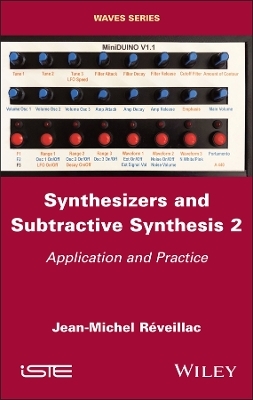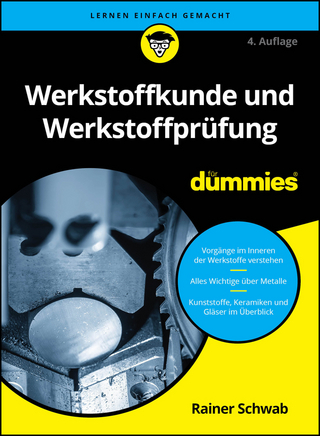
Synthesizers and Subtractive Synthesis, Volume 2
ISTE Ltd and John Wiley & Sons Inc (Verlag)
978-1-78630-925-9 (ISBN)
Synthesizers and Subtractive Sound Synthesis 2 presents practical exercises, ranging from the fundamentals to advanced functionalities. Most of the sound effects applicable to subtractive synthesis are covered: vibrato, phaser, reverb, etc. The final chapters deal with polyphony and arpeggiator-sequences.
Jean-Michel Réveillac is an associate lecturer at the University of Burgundy, France. He is a consultant to media companies and runs a sound restoration, mixing and transcoding studio. He has specialized in sound processing and synthesis for 35 years.
Preface ix
Introduction xiii
Chapter 1 Subtractive Synthesis: The Beginning 1
1.1 Exercise 1 -- generate sound with a single oscillator 2
1.1.1 Behringer Neutron 2
1.1.2 Behringer 2600 (ARP 2600) 4
1.1.3 Max/MSP 6
1.1.4 Pure Data 8
1.1.5 VCV Rack 10
1.2 Exercise 2 -- associate an envelope 12
1.2.1 Behringer Neutron 12
1.2.2 Behringer 2600 (ARP 2600) 13
1.2.3 Max/MSP 15
1.2.4 Pure Data 16
1.2.5 VCV Rack 18
1.3 Exercise 3 -- add a filter 18
1.3.1 Behringer Neutron 19
1.3.2 Max/MSP 20
1.3.3 Pure Data 21
1.3.4 VCV Rack 23
1.4 A little further with Max/MSP, Pure Data and VCV Rack 24
1.4.1 ADSR with Max/MSP 24
1.4.2 Filter with Max/MSP 25
1.4.3 Configurable filter with Max/MSP 26
1.4.4 Custom waveforms with Pure Data 28
1.4.5 ADSR with Pure Data 30
1.4.6 Signals and filters with Pure Data 32
1.4.7 Additional modules with the VCV Rack 35
1.5 Final remarks 36
Chapter 2 Subtractive Synthesis: The Fundamentals 37
2.1 Exercise 4 -- adding an envelope to the filter 38
2.1.1 Minimoog 39
2.1.2 Behringer 2600 (ARP 2600) 41
2.1.3 Max/MSP 42
2.1.4 Pure Data 46
2.1.5 VCV Rack 49
2.2 Exercise 5 -- integrating an LFO 50
2.2.1 Minimoog 52
2.2.2 Novation Bass Station II 56
2.2.3 Max/MSP 58
2.2.4 Pure Data 62
2.2.5 VCV Rack 64
2.2.6 Reaktor 67
2.3 Exercise 6 -- multiple oscillators 71
2.3.1 Minimoog (or clones) 71
2.3.2 Novation Bass Station II 75
2.3.3 Max/MSP 76
2.3.4 Pure Data 80
2.3.5 VCV Rack 82
2.3.6 Reaktor 83
2.4 Exercise 7 -- noise generator 86
2.4.1 Minimoog 86
2.4.2 Behringer 2600 (ARP 2600) 89
2.4.3 Novation Bass Station II 90
2.4.4 Max/MSP 91
2.4.5 Pure Data 95
2.5 To conclude classic synthesis 97
Chapter 3 Advanced Subtractive Synthesis 99
3.1 Exercise 8 -- ring modulation 100
3.1.1 Behringer 2600 (ARP 2600) 102
3.1.2 Arturia MatrixBrute 103
3.1.3 Novation Bass Station II 104
3.1.4 Max/MSP 106
3.1.5 Pure Data 107
3.1.6 VCV Rack 110
3.1.7 Reaktor 111
3.2 Exercise 9 -- sample and hold 113
3.2.1 Behringer 2600 (ARP 2600) 114
3.2.2 Arturia MatrixBrute 115
3.2.3 Max/MSP 116
3.2.4 Pure Data 119
3.2.5 VCV Rack 121
3.2.6 Reaktor 122
3.3 Sound effects 125
3.3.1 Exercise 10 -- reverberation 126
3.3.2 Exercise 11 -- chorus 141
3.3.3 Exercise 12 -- flanger 149
3.3.4 Exercise 13 -- phaser 157
3.4 Conclusion 164
Chapter 4 Duophony, Paraphony and Polyphony 165
4.1 Exercise 14 -- duophony and paraphony 166
4.1.1 Behringer 2600 (ARP 2600) 166
4.1.2 Novation Bass Station II 168
4.1.3 Behringer Neutron 170
4.1.4 Arturia MatrixBrute 172
4.2 Exercise 15 -- polyphony 173
4.2.1 Max/MSP 174
4.2.2 Pure Data 181
4.2.3 VCV Rack 186
4.2.4 Reaktor 190
4.3 Conclusion 193
Chapter 5 Sequencers and Arpeggiators 195
5.1 Exercise 16 -- sequencers and arpeggiators 197
5.1.1 VCV Rack 197
5.1.2 Reaktor 203
5.1.3 Max/MSP 211
5.1.4 Pure Data 223
5.2 Conclusion 230
Conclusion 233
Appendix 1 USB Connectivity 237
Appendix 2 Pure Data Extensions 239
Appendix 3 Keyboards and Interfaces 249
Appendix 4 MIDI Notes, Numbers and Frequencies 253
Glossary 257
References 265
Index 275
| Erscheinungsdatum | 22.08.2024 |
|---|---|
| Verlagsort | London |
| Sprache | englisch |
| Gewicht | 703 g |
| Themenwelt | Naturwissenschaften ► Chemie |
| Technik | |
| ISBN-10 | 1-78630-925-4 / 1786309254 |
| ISBN-13 | 978-1-78630-925-9 / 9781786309259 |
| Zustand | Neuware |
| Informationen gemäß Produktsicherheitsverordnung (GPSR) | |
| Haben Sie eine Frage zum Produkt? |
aus dem Bereich


